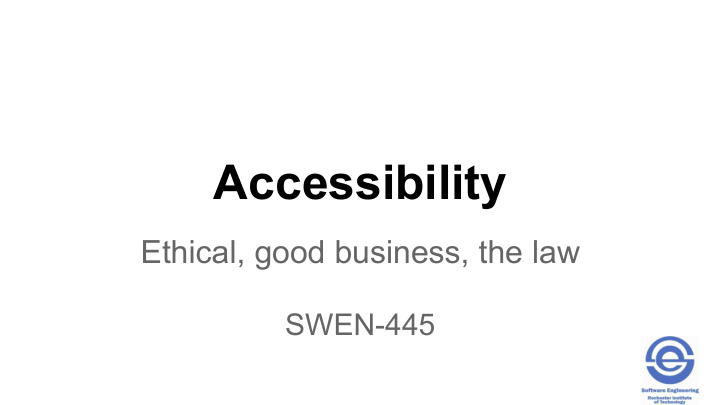



Accessibility Ethical, good business, the law SWEN-445
Topics • Software ethics • Visually impaired • Deaf and hard of hearing • Dexterity and mobility impairments • Section 508 – the law
Accessibility – a Case of Software Ethics “In a fair society, all individuals would have equal opportunity to participate in, or benefit from, the use of computer resources regardless of race, sex, religion, age, disability, national origin or other such similar factors.” —ACM Code of Ethics The UN Convention on the Rights of Persons with Disabilities recognizes access to information and communications technologies, including the Web, as a basic human right.
Accessibility for the Web “The power of the Web is in its universality. Access by everyone regardless of disability is an essential aspect.” Tim Berners-Lee, W3C Director and inventor of the World Wide Web
Accessibility definition has changed.
Accessibility benefits multiple personas.
Visually Impaired • Visual impairments - low vision, color blindness, and total blindness • Tunnel vision, cataracts, peripheral visual field restrictions and loss of visual acuity. • Some visual impairments may cause difficulty seeing in low light levels, problems judging speed and distance, or painful irritation in bright light. • Only about 4% of people who have visual impairments are totally blind.
Visually Impaired • Research shows that most partially sighted people are able to read clear large print comfortably. • Large print size - 14 point or above • So a simple way to increase accessibility to the visually impaired. • When print is not suitable, Braille or voice is an option. • The actual number of fluent Braille users is small (less than 10% of the blind) • But it is a useful medium and can also be used by deaf blind people.
Visually Impaired: Assistive Technology Screen enlarger Braille display Braille embosser
Color Blindness • Photoreceptors vary greatly from person to person • People with photoreceptors that do not respond to certain frequencies do not perceive those colors in the same way that other people do; “color blindness” • 8% of male individuals • 0.4% of female individuals http://www.colourblindawareness.org/
Types of Color Blindness Protanopic color vision, Deuteranopic color vision, Normal trichromatic no ability to perceive red no ability to perceive green color vision Normal Deuteranopic
Deaf and Hard of Hearing • Hearing difficulties range from slight hearing loss to deafness • Hearing impaired might be able to hear some sound, but might not be able to distinguish words • People born profoundly deaf may have difficulty in acquiring a clear understanding of spoken and written language • Many hearing impaired people can lip read to some extent • Requires concentration and is tiring over long periods. • More popular with people who lost hearing later in life, or who have some residual hearing. • Sign Language is a common communication method https://www.youtube.com/watch?v=33krnU_juFE
Deaf and Hard of Hearing • Hearing aids are often used in addition to other forms of communication • Hearing aids amplify all sounds, including background noise, and may not be suitable in some circumstances • Technology considerations: • Communicate information visually, e.g., … § Flash when beep occurs § Video sign language • Sound amplification § Adjust sound options and volume • Translate speech to text • Research – ASL to and from speech using gesture recognition technology (e.g., Microsoft’s Kinect)
Dexterity and Mobility Impairments • Difficult to use a standard keyboard, mouse, or other peripherals • Individuals experience pain, discomfort, loss of feeling • Individuals may also have a reduced range of physical movement or complete loss of physical capability • In their fingers, hands, wrists, or arms, • Difficulties / impairments can be caused by a wide range of common illnesses and accidents such as carpal tunnel, arthritis, stroke, cerebral palsy, Parkinson's disease, multiple sclerosis, loss of limbs or digits, and spinal cord injuries, among others • Can be stable, degenerative or intermittent, depending on the cause • Manual dexterity impairments result in the loss of fine control of movement, affecting typing and the use of the mouse/peripherals
Dexterity Impairments: Assistive Technology • Keyboards may be altered to make typing with the fingers easier, or can be adapted to be used by a (head) pointer. • Voice/Speech recognition systems • Users can give commands and enter data using voice • On-screen keyboard programs • Provide an image of a standard or modified keyboard Head Pointer on the computer screen. • The user selects the keys with a mouse, touch screen, trackball, joystick, switch, or electronic pointing device. • Keyboard filters • Include typing aids, such as word prediction utilities • Reduce the required number of keystrokes. • Alternative input devices • including alternative keyboards, electronic pointing devices, sip-and-puff systems, wands and sticks, joysticks and trackballs Sip/puff switch
Section 508 • Section 508 is an amendment to the United States Workforce Rehabilitation Act of 1973 • Mandates that all electronic and information technology developed, procured, maintained, or used by the federal government be accessible to people with disabilities • Good accessibility design guidelines in general
W3C Accessibility Design Guidelines • Web Content Accessibility Guidelines (WCAG) http://www.w3.org/WAI/intro/wcag • “explain how to make web content more accessible to people with disabilities”; principles … • Perceivable objects and content • Operable objects and navigation • Understandable content and interactive operation • Robust – reliably interpretable by assistive technologies • Accessible Rich Internet Applications (ARIA) http://www.w3.org/WAI/intro/aria • Guidelines for how to make dynamic web app functionality available to assistive technologies
Individual Activity • Search the web for 3 anecdotes about software accessibility. Add the anecdotes, with links, to a doc file. • Analyze the anecdotes. Design or implementation problems? Any ideas how to improve the accessibility of the mentioned software? • Submit the document to myCourses.
References • See myCourses for some specific resources • Ben Schneiderman, “Universal Usability”, CACM, May 2000 • Some overview material from: • http://www.microsoft.com/enable/guides/default.aspx • http://www.shef.ac.uk/disability/adtrain/8_support.html • Read about Learning Disability material at: • http://www.ldaamerica.org/aboutld/teachers/understanding/types.asp • US Government usability site: • http://www.usability.gov/index.html
Recommend
More recommend